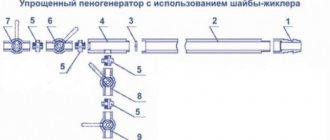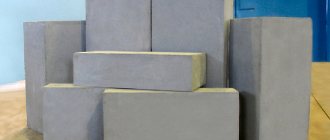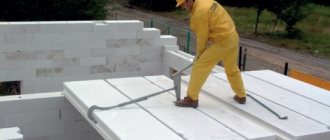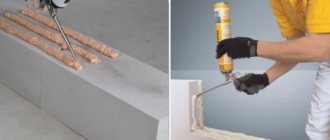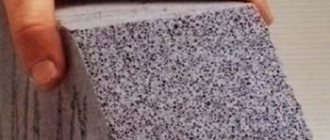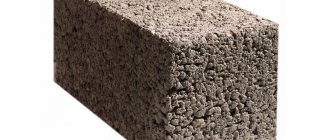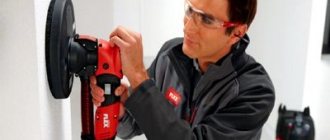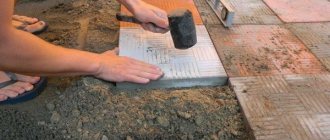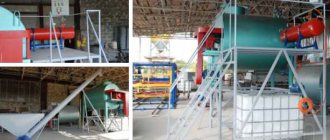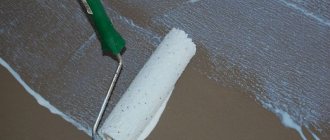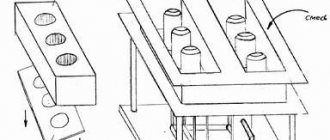You can make foam concrete with your own hands if you know the manufacturing technology. The cost of this material is low, and the quality meets all requirements. Foam concrete has numerous advantages, including resistance to heat and open flame, low shrinkage rates, water absorption, resistance to heat loss, and aggressive influences. Unlike many modern building materials, foam blocks can be made independently, having decided on the proportions and characteristics of the future mixture. The strength of the material will largely depend on the composition and adherence to technology. To work, you will need inexpensive equipment. You will definitely have to purchase a concrete mixer that allows you to make a high-quality mixture.
Aerated concrete requires the use of a special autoclave, which makes mixing it yourself impractical and expensive. Foam concrete does not have such a drawback, since the mixture hardens under natural conditions and does not require expensive devices. To produce blocks, you can use factory-made ready-made molds. They are sold in construction stores; if desired, the forms can be assembled yourself from plywood or metal sheets.
To work you will need the following equipment:
- molds intended for casting blocks (it all depends on the purpose of the material and the required size);
- mixer for mortar (such building mixtures cannot be made manually);
- do-it-yourself foam generator for foam concrete or a ready-made one (can be purchased in specialized stores);
- a compressor designed to operate with an alternating voltage of 220 V and a pressure of 6 atm.
When planning to make blocks from foam concrete, you should take care of the room where the work will be done and the castings will dry. The place should be spacious, free from unnecessary objects, construction debris, and dust. A source of electricity is required to operate the equipment.
Design Features
It is no secret that manufactured foam concrete of various categories is widely used in modern construction. The popularity of these building materials is quite logical, since they have a wide range of advantages, which almost does not affect their price. To understand the design features of a self-made foam generator for foam blocks, you need to thoroughly study the main components and parameters of the building material that you want to obtain as a result. In this case, foam concrete is considered, which is made from the following set of main components:
- cement;
- foaming composition;
- water;
- sand.
It must be emphasized that independent production of foam blocks is a justified process in material terms.
The cost of this building material is much lower than that of its analogues, which are presented on the building materials market. This is due to the fact that the technology for producing industrial analogues of foam concrete is much more complex.
If we touch on the material aspect, the largest costs are noted only during the purchase of cement. The remaining components in total do not exceed the cost of the required volume of concrete.
Operating principle of the equipment
To date, engineers have tried to create the simplest and most accessible drawings of a foam generator for foam concrete with their own hands. To produce reliable and high-quality equipment, it is necessary to understand the principle by which this device works. Using this equipment, foam is produced, which forms the basis of foam concrete. An industrial device traditionally has three different modules that ensure smooth operation of the entire structure and the performance of its main function, namely:
- a control element with which you can ensure automatic dosing of the product;
- modules that produce foam and also transport it. With their help, it is possible to obtain foam.
The foam generator contains a pre-prepared cement mortar, which, under the influence of a given pressure, mixes with air and is converted into foam concrete.
As practice has shown, this device is not only inexpensive, but also productive. Thus, it is quite possible to make a foaming agent for foam concrete with your own hands, which is capable of producing approximately 500 liters of material in one minute.
Purpose of installations for porousization of cellular concrete
- Installations for porous concrete perform their direct function - they generate the air phase in the mixture until the entire mass is homogeneous.
- The installation for porous concrete must meet the following requirements and provide:
- Uninterrupted supply of foam mass directly to all types of mixing parts of the system.
- It is desirable that the device be adapted for all types of both domestic and foreign foam concentrates.
- The device must process the volume of foam at an average speed of at least 300–500 l/min. or about 6–9 l/sec.
- Equipment performance must be determined and strictly correspond to the required production capacity; it is advisable to select devices with a performance reserve. For example, for 1 m3 of foam concrete material with density characteristics of about 800–900 kg/cub. m. will require an average of about 400–500 l/foam mass.
The average time to obtain such a volume of foam starts from 1–5 minutes. and depends on the power of the foam generator. The volume of foaming agent required to obtain 500 l/foam is about 20 l. Based on the average calculation indicators, the appropriate type of foam generator is selected.
Varieties and popular units
The construction market offers several types of foam generators: reversible (cyclic) and non-reversible (continuous).
The latest type of foam generators for the production of foam concrete allows the operator to ensure regular transportation of the manufactured foam composition to the foam concrete mixer. Unlike this type, the operator of reversible equipment must independently, before any new start-up, add a foaming compound to the receiver and perform a large number of manipulations with the air supply and supply valves. Foam-generating models of a non-reversible type make it possible to reduce both the costs of the required components that are used in the process and working time.
Today, the majority of both foreign and Russian manufacturers offer various devices for generating foam. Among domestic manufacturers, it is necessary to highlight Fomm-PGM and Sunny-PG 150, which are represented by the company from St. Petersburg Stroy-Beton, VM-PG6000, which is offered by Kirov LLC Construction Technologies, as well as PG-AV equipment , made from Perm.
We need to dwell in more detail on Fomm-PGM, since this equipment is known both in our country and abroad.
The equipment performed excellently during operation. Automated, reliable, working with any type of foaming agent and easily adjustable, the unit produces five hundred liters of foam per minute. Like many non-reversible models, Fomm-PGM consists of the following modules:
- dosing digital automatic module, through which you can produce the required volume of foam composition of a predetermined quality, by pressing only one key - “Start”. This makes it possible to avoid the influence of the human factor on the quality composition of the foam;
- a converting module, where a foam mixture is obtained using a tube;
- a composition supply module, which itself supplies a foam concentrate solution made by the operator from any tank. Due to the installed module, the device is semi-automatic.
The production of foam concrete using the Fomm-PGM foam generator is fast and cost-effective. An important advantage is the ability to work simultaneously with a concrete mixer, mortar unit or plastering station.
The weight of the device is 65 kg, and the dimensions are 1350x750x850mm. The density range can be varied from 25 to 250 g/l, and the air pressure is 6 Atm. This equipment consumes only 3 kW/h. One operator is required for maintenance.
Components and proportions
Durable foam concrete blocks require precise proportions and adherence to production technology. Failure to comply with the rules will lead to the fact that the quality of the material will be extremely low, and foam concrete will lose strength. For manufacturing, you need to correctly calculate the proportions and select the components.
For mixing you will need:
- cement (of a suitable brand corresponding to the purposes of producing foam concrete);
- sifted washed sand (without inclusions of clay and other impurities);
- clean drinking water (technical water is not suitable);
- foaming agent
To make high-quality material, you need to correctly calculate the number of components. Their proportion is selected taking into account the brand. For example, for a cube of concrete grade D400 you will need:
- clean water (in cold weather it should be warmed up a little) - 160 l;
- foaming agent for foam concrete - 850 g;
- washed (necessarily dry) sand - 120 kg;
- cement of the required grade (determined depending on the purpose) - 300 kg.
To build a house you will need foam concrete grade D600-1000. This composition at home is suitable for building a small cottage in a region with weak seismic activity. To make a cubic meter of mixture you need to take:
- water - 180 l;
- foaming agent - 1100 g;
- sand - 210 kg;
- cement - 330 kg.
The best option for making a foam concrete composition at home for the construction of a small country house is the following (per cubic meter of finished concrete):
- water - 230 l;
- foaming agent - 1100 g;
- dry sand - 340 kg;
- cement - 400 kg.
DIY assembly
Before starting to manufacture the device, you must first prepare an assembly diagram for the future unit.
The device diagram includes control valves that set the required density when making foam, as well as shut-off mechanisms that can shut off the entire system when necessary.
You need to put the components of the device on the diagram :
- washer-jet or nozzle;
- mixing chamber;
- foam cartridge;
- foam supply and exit areas.
The mixing chamber is the main component of the device. It will receive a pre-prepared mixture. In the chamber, the composition is thoroughly mixed and, under the influence of a given pressure, flows through a truncated washer-nozzle. During entry into the system, the composition compresses under pressure, and during exit from the device it begins to expand. As the solution expands, its transport speed increases. When leaving the nozzle washer, the cement composition enters the foam cartridge, in which it is converted into a foamy substance.
If the unit needs to be operated temporarily, and its increased productivity is not an important parameter, you can install a Laval nozzle instead of a washer-nozzle.
To assemble the device you will need:
- hoses;
- metal sheets;
- welding machine;
- pipe;
- adjustable and shut-off valves;
- compressor;
- submersible pump.
First you need to assemble a tank, where air and cement mixture will be supplied in the required volume.
Any iron container with a cylindrical shape is perfect for this purpose. To organize a constant supply of solution to the device, it is necessary to install a hose and a pump. A second hose is required to supply compressed air to the structure. Using a special valve, you can regulate the pressure inside the device.
The Laval nozzle is installed separately in the device body. A channel should also be installed in the structure, which will begin to compress and expand in certain areas. The foam cartridge is the final part of the system, but its installation is the most important part in the design. This is explained by the fact that foaming occurs precisely in this place. In order for the foam cartridge to produce foam, it must be filled with ordinary dishwashing items - nets or hedgehogs.
Important nuances
There are no ways to manufacture any equipment that would not imply the presence of some nuances. Due to the nature of the construction industry, do-it-yourself assembly of devices for the production of building materials has special specifics. Experts identify the following requirements:
- central hole size - 10 mm;
- a 3:1 ratio is suitable for proportional dimensions of nozzle depth and exit diameter;
- the depth of the nozzle and its inlet diameter should be no more than 30 mm and be in a ratio of 1:1.
To make a foam cartridge, you need to choose a wire mesh rather than a spiral mesh. It is best to give preference to meshes made of stainless steel. They, like a foam exit filter from the device, can be purchased at the store.
The foam cartridge body must be filled with nets, and a brush must be secured at the outlet. You don’t have to use a brush, but in this case you won’t be able to avoid foam splashing at the exit of the nozzle. Manufacturing a foam generator with preliminary preparation will not be very difficult, and the resulting device will serve well for a long time.
Foaming agent recipe
The solution can be stored for 4 weeks.
As a rule, foam concentrates are sold in large quantities in construction markets. But there are cases, especially in private small-scale construction, when very little concentrate is needed for foam concrete. Here builders can try making their own foaming agent.
The solution should include:
- pine rosin;
- caustic soda;
- carpentry bone glue.
One kilogram of rosin mixed with glue produces about 500 liters of foam. If you adhere to all manufacturing rules, you can achieve a homogeneous material, the pores of which will be no more than 0.4 mm wide. Preparation of the product takes about two hours. The temperature of the composition at which you can work with it is permissible from 5 to 30 degrees Celsius. The maximum permissible shelf life of the solution is 4 weeks.
Return to contents
